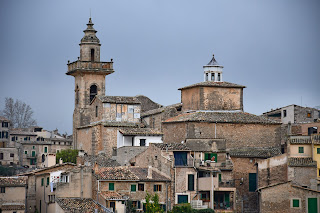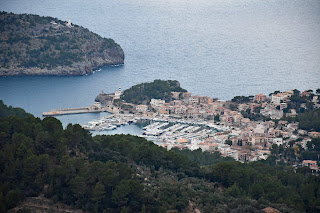Mallorca – Day 1: Serra de Tramuntana
Flying into Mallorca is a magical experience. As soon as the island draws into view, it dramatically unfurls its rows of craggy mountains into the sea. The peaks occasionally gleam with a patch of sunlight but mostly maintain a dark mien; forming a high range along the northeastern coast, they hold back a barrage of dark clouds from pouring over the southern flatlands. These, the visitor soon observes, are dotted with a host of old windmills: round and quadrilateral, painted and bare, they find themselves in various stages of disrepair.
Once we rented our car
in Palma, my dad and I set off for Valldemossa, a quaint town nestled in the
Tramuntana range north of the island’s capital. We made this decision at the
last minute since it took us forever to agree on our itinerary for the trip. Indeed,
we didn’t even book a hotel in advance.
We found Valldemossa
windy, cold, and covered in clouds. Although the town itself was undeniably
pretty, the weather made it difficult to comprehend why Chopin and George Sand
decided to spend an entire winter there instead of visiting a sunny beach somewhere
close to Palma. It is no wonder that the composer’s tuberculosis got worse on
this trip, especially if he had weather as bad as ours. Due to the holidays,
the Carthusian Monastery was closed, so we spent our few moments in Valldemossa
walking along alleys and viewing the valley from lookout points.
Our next stop was
Sóller. Closer to the sea than Valldemossa, the town is split into two
settlements: Sóller proper and Port de Sóller, which are connected by a tunnel
facing seaward. The more inland part of Sóller stands in the shadow of the
massive Saint Bartholomew Church, whose circular, highly patterned rose window
belongs to the island’s finest. Approaching the town, we discovered that many
of the roads leading to the centre were closed for the day’s festivities. A
lengthy search finally allowed us to penetrate the historical area, and after
some clueless driving we even found a parking lot.
We did not stay long
in Sóller as its most important churches were closed, though we did find one
attraction we had not expected to see: out of order in the winter, the
historical wooden trams all stood at the depo. Continuing to Port de Sóller, we
took in a few views of the seaside town, now shimmering in the light of the
setting sun. The port is rather unremarkable in the winter, but I wager it must
be quite a bustling destination in warmer months.
The night fell quickly
as we left Sóller. I found this quite discomfiting as much of the winding
mountain road still lay ahead of us, and every time we had stopped the car to
admire the roadside views, we heard the bleating of fearless and unpredictable
sheep. Nevertheless, we plodded on, impelled by the necessity of finding
accommodation and a supermarket where I might buy a toothbrush (despite making
a note to myself on the previous day, I forgot mine at home).
We reached Sanctuari
de Lluc with its Basilica de la Mare de Déu in the evening hours. We knew that
the basilica would still be open, and having arrived late, we found it
completely empty, the warm shimmer of its carved wood and golden decorations
reserved for our eyes alone. Although the festive season has made life more
difficult for us in some ways, it was nice to see the aisle adorned with
drooping garlands of paper snowflakes. The basilica, we learned from our
guidebook, was founded on a site where a young shepherd once found a statue of
the Virgin Mary. Despite being brought to a nearby church many times, the
statue always mysteriously returned to the place where it was discovered, for
which reason a church was built there instead.
Although we knew the
sanctuary now functions as a hotel, we decided to continue northwards in the
direction of Pollença. We figured that being this close to the northern tip of
the island would give us a head start on our morning drive to the cape of
Formentor. Our intensive internet search eventually led us a little farther to
the east, as all hotels in and around Pollença were either booked out or
absurdly expensive. Instead, we found a hotel in the beautiful walled town of Alcúdia.
For dinner, I had a tumbet, a vegetarian dish typical of Mallorca that consists
of eggplants, zucchini, and red peppers.






























Comments
Post a Comment